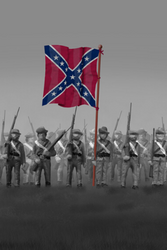Civil War Troop Organization
16th Jul 2020
A battery was an intricate organization of men, horses, and ordnance. There were multiple duties for each man to perform when not in battle including care of the horses, gun and carriage maintenance, and routine stock duties. In battle, each man had a specific assignment to serve the gun, though many were cros/trained and could perform other duties when required. One battery in the Union army consisted of six cannon, all of similar type and caliber and each with its own limber and caisson. Teams of six horses were used to pull the limbers and caissons that held ammunition chests containing the different types of shells used in each gun. The gunners walked during the march or trotted alongside the limbers when moving into a position. Only when the situation called for fast movement did they ride on the limbers and caissons when going into battle. Once in position, the gunners would unlimber the cannon and the limber would move to a position directly behind the gun. The caisson team would move to a location behind the limber to await further orders.
Confederate batteries were smaller, composed of only four guns and often of different types and calibers. For example, Captain Charles Fry''s Virginia Battery, the "Orange Artillery", had two 3-inch Ordnance Rifles and two 10-pounder Parrott Rifles. Captain Hugh Ross'' Georgia Battery had one Napoleon, three Parrott Rifles, and one Naval Parrott Rifle. Due to a scarcity of horse reserves in the south, Confederate batteries were forced to limit their horse teams to only four animals. Mules were used when horses were unavailable, but they were not considered a satisfactory substitute as they were more difficult to control.

In the Army of the Potomac, the artillery was organized by brigades. One brigade was commanded by a major, lt. colonel or colonel though several were commanded by captains, and was composed of four to five batteries. Every corps had one artillery brigade assigned to it for the use of the corps commander. The artillery brigade commander was responsible for posting his batteries and making certain that each was properly serviced and supplied. Two brigades of horse artillery were assigned to the Army of the Potomac''s Cavalry Corps. The army also had a well organized Artillery Reserve composed of five brigades. These reserve brigades supplied extra batteries to support the batteries assigned to the infantry corps, and added an extra amount of firepower when and where it was needed.
The Army of Northern Virginia organized its artillery into battalions, each commanded by a major or colonel. One battalion was composed of four batteries and one battalion was assigned to an infantry division. For example, Major William T. Poague''s Battalion, assigned to Pender''s Division of Hills Corps, was composed of the Albemarle (Virginia) Battery, the Charlotte (North Carolina) Artillery, the Madison (Mississippi) Light Artillery, and Brooke''s Virginia Battery. In addition, each of the three army corps had an artillery reserve of two battalions. Despite the larger number of artillery organizations in Army of Northern Virginia, the Union held the advantage in the actual number of guns present during the battle. Many of the Confederate batteries were understrength and missing their total compliment of cannon.


 Gift Cards
Gift Cards